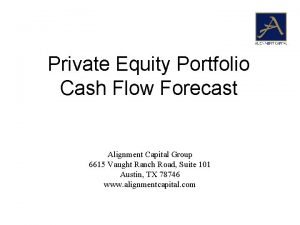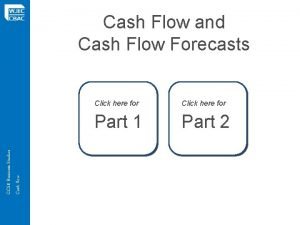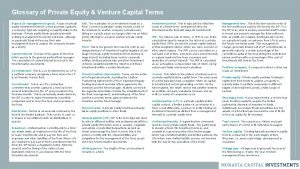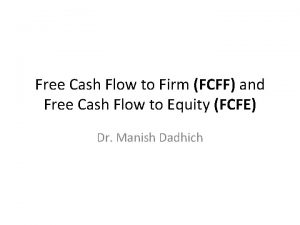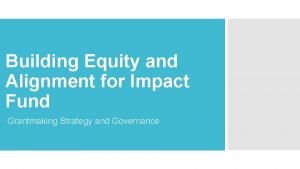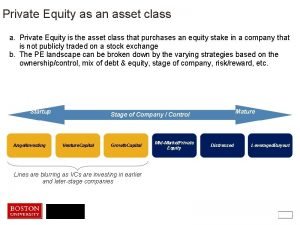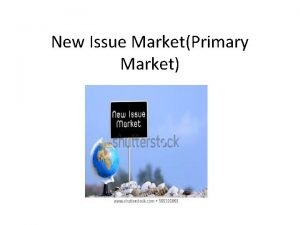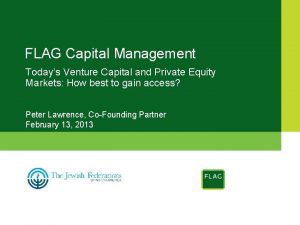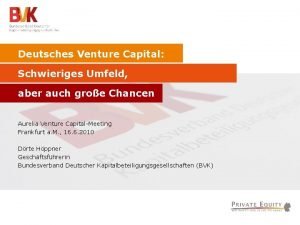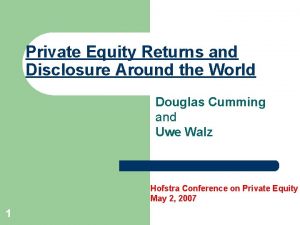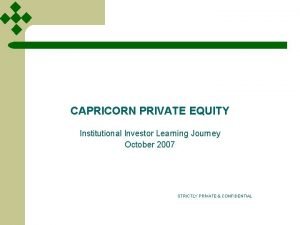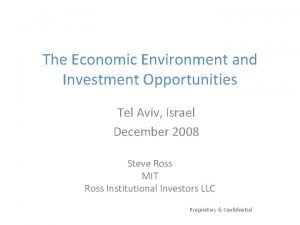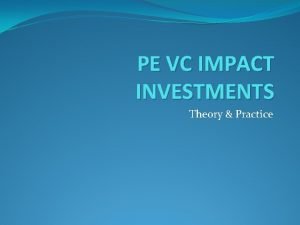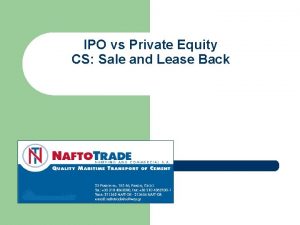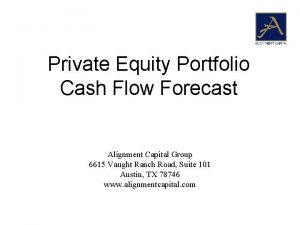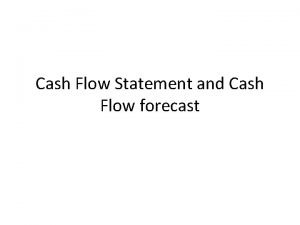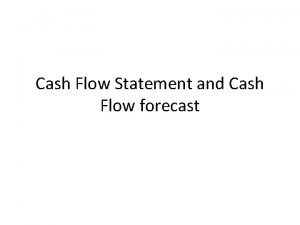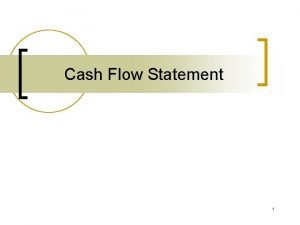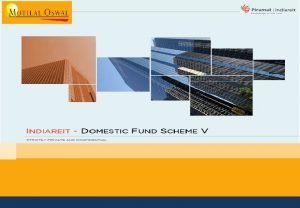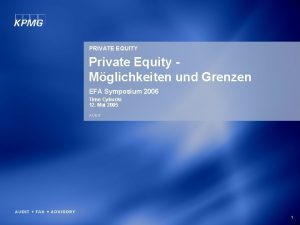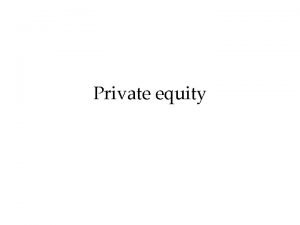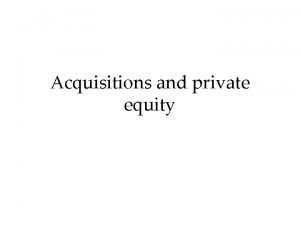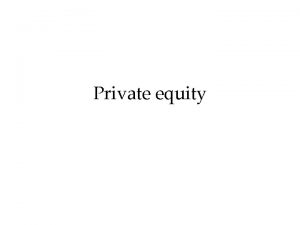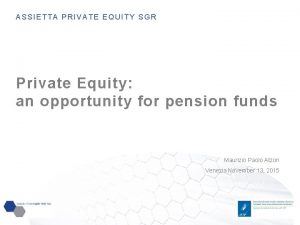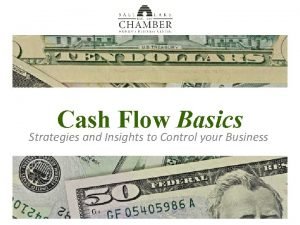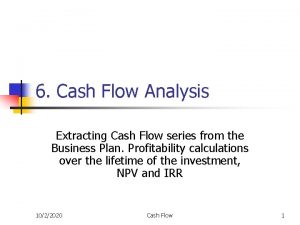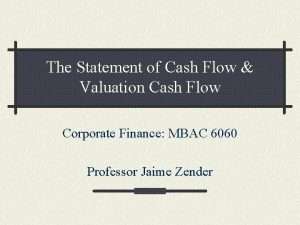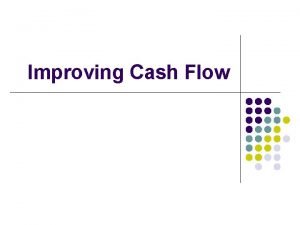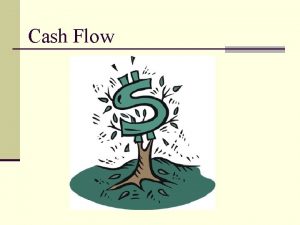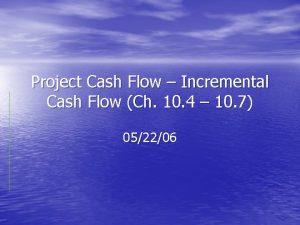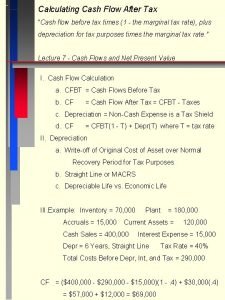Private Equity Portfolio Cash Flow Forecast Alignment Capital


























- Slides: 26

Private Equity Portfolio Cash Flow Forecast Alignment Capital Group 6615 Vaught Ranch Road, Suite 101 Austin, TX 78746 www. alignmentcapital. com

The Necessity for a Probabilistic Approach Timing of realization is certain in the public market because it is at the choosing of the investor. Private equity has no certainty at all. Timing Amount Bonds (held to maturity) Certain Bonds (not held to maturity) Certain Uncertain Stocks Certain Uncertain Private Equity

The Necessity for a Probabilistic Approach Because of the uncertain nature of cash flows in the private markets, our entire career as a team has been built around understanding the relative likelihood of a specific investment outcome or set of investment outcomes, whether in determining the amount and timing of the investment or the amount and timing of the return of the investment. We therefore express risk in terms of the likelihood of a specific outcome or set of outcomes. Everything we do is an attempt to quantify how much we do know versus how much we don't know about the cash flows related to private investments. We believe that we are one of the very few firms in the business that can provide a principled, coherent analytical tool set for that purpose.

ACG’s quantitative tools make it possible to match a portfolio’s risk and return characteristics against the industry to arrive at an accurate cash flow forecast.

Quantitative Characteristics Return (Benchmark) Ø Index comparison method (ICM) – return over a public market benchmark (using an end of period assumption) Period 0 1 2 3 4 5 6 7 8 9 IRR Cash flow ($100) $0 ($300) $0 $0 $405 $0 $0 $0 $205 9. 19% S&P Cumulative Index S&P Comparison 5. 00% -10. 00% -15. 00% 20. 00% -10. 00% 5. 00% 15. 00% 25. 00% 1. 050000 0. 945000 0. 803250 0. 963900 0. 867510 0. 910886 1. 047518 1. 309398 1. 636747 Compound 5. 63% 105. 000 394. 500 335. 325 402. 390 (42. 849) (44. 991) (51. 740) (64. 675) (80. 844) Index Comparison Return ($100) $0 ($300) $0 $0 $405 $0 $0 $0 ($81) ($76) -9. 24% Invented by the Alignment principals, now in general use.

Quantitative Characteristics Risk/Return Profile • OCOM Methodology* – Determine regression line of outcomes Beta =. 78 (portfolio has 78% of the variability of outcome of the index) * Patent pending Alpha =. 01 (excess return of 1% if the index outcome were zero) Each dot is an ICM outcome Square root of R squared =. 65 (about 65% of the private investment outcome is explained by the index outcome)

Quantitative Characteristics Risk/Return Profile • OCOM Methodology* (cont. ) – Calculate risk of private equity using knowns from public market * Patent pending Here, β is the slope and r is the coefficient of correlation of the OCOM plot and σ is the risk of the S&P 500 index over a particular time period.

Quantitative Characteristics Risk/Return Profile By Strategy Significantly out of line with industry history

Quantitative Characteristics Risk/Return Profile By Vintage Unusually consistent positive risk-adjusted performance

Quantitative Characteristics Portfolio Maturity Mature Immature

Quantitative Characteristics Portfolio Maturity

Quantitative Characteristics Portfolio Composition (based on commitments)

Quantitative Characteristics Performance Attribution* * Patent pending Overall selection return is positive, indicating a highquality portfolio.

Portfolio Projection • Note: – In the graphs on the following pages, • The gray banded areas represent typical industry performance over very long periods of time; • The red line in each graph represents portfolio performance through 2002; • The gold line is the base case, which takes the prior performance of the portfolio and current market conditions into account; • And the black and green lines are the worst and optimistic cases, respectively.

Portfolio Projection • A word about the cases – Assumptions common to all cases • Capital drawn in the future will not exceed remaining undrawn capital (i. e. , capital commitments less capital already drawn). • The stochastic distributions used were derived from data in the Venture Economics database. • Except for the Base case, the stochastic distributions were derived from all data points of all vintages in the database. – Thus, funds with complete write-offs and funds not returning capital were considered, in addition to better-performing funds.

Portfolio Projection • A word about the cases – Base case • Probabilities of cash flows were extracted from vintages representing prior recoveries from industry troughs. – Venture capital: 1982 – 1987 – Buyouts: 1986 – 1988, 1995 – 1997 • Within these vintages, all funds were considered (including those with distinctly substandard returns)

Portfolio Projection • A word about the cases – Optimistic case • All vintages that have drawn capital at a faster than usual rate will slow down • All vintages that have drawn capital at a slow rate will continue to do so • All vintages that have returned capital more slowly than usual will speed up • All vintages that have returned capital quickly will continue to do so

Portfolio Projection • A word about the cases – Worst case • All vintages drawing capital at a rapid rate will continue to do so • Vintages drawing at a slower rate will speed up • All vintages returning capital faster than normal will slow down • All vintages returning capital at a slow rate will continue to do so.

Summary of Cases • The base case assumes that the industry will recover from its current trough in about the same fashion as it has recovered from the prior two troughs. • The optimistic case assumes an immediate return to the mean for the industry and portfolio as a whole. • The worst case assumes that there will be no return to the mean and requires a global macroeconomic upheaval – possible, but in our view extremely unlikely.

Portfolio Projection • Although capital drawn in the portfolio accelerated in 2000… • …cumulative actual draws are about on track, with the base and optimistic cases spot on.

Portfolio Projection • Actual return of capital, on the other hand, is badly off track… • …although an adequate return is still highly probable.

Portfolio Projection • Positive net cash flow is anticipated to be later, and probably less than usual, for this portfolio… • …but cumulatively it is very highly probable that the portfolio will recover invested capital.

Return of Capital Portfolio Base Case (the gold line in the previous graphs) Note that there is no measurable risk of returning < $500 million.

Return of Capital Portfolio Optimistic Case (the green line in the prior graphs) There is no measurable likelihood of failing to deliver $500 million in the optimistic case.

Return of Capital Portfolio Worst Case (the black line in the previous graphs) Even in the worst case, the probability of < $500 million return of capital is under 1%, with the minimum observed of $382. 3 million.

Conclusion • Our stochastic analysis suggests that the example portfolio has a very high probability of returning $500 million or more between now and 2011 (worst case probability of 98 bps of not doing so). • Our qualitative and quantitative review of the portfolio indicates that this is a well chosen, well diversified portfolio of fund managers. In light of these factors and the industry’s demonstrated ability to recover from prior troughs, we believe that the worst case scenario should have no more than a 5% probability. Therefore we believe that in the worst case there is no more than a 5 bps probability of not returning $500 million.
 Private equity cash flow forecasting
Private equity cash flow forecasting Cash flow forecast business studies
Cash flow forecast business studies Private equity glossary of terms
Private equity glossary of terms Fcf vs fcfe
Fcf vs fcfe Global alignment
Global alignment Dna substitution
Dna substitution Global alignment vs local alignment
Global alignment vs local alignment Global alignment
Global alignment Global vs local alignment
Global vs local alignment Building equity and alignment
Building equity and alignment Jasper private equity
Jasper private equity Private equity asset class
Private equity asset class Meaning
Meaning Lbo case study
Lbo case study Flag private equity
Flag private equity Aurelia private equity
Aurelia private equity Private equity career
Private equity career Aavin private equity
Aavin private equity Private equity returns and disclosure around the world
Private equity returns and disclosure around the world Capricorn private equity
Capricorn private equity Hccg private equity
Hccg private equity Private equity
Private equity Private equity
Private equity Private equity market
Private equity market Dvpi private equity
Dvpi private equity Navatar private equity
Navatar private equity Ipo vs private equity
Ipo vs private equity
